Area : 20.815 km²
Population : 1.719.751 (2000)
Traffic Code : 07
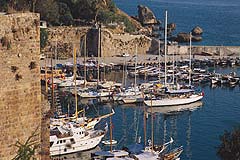 Because of the archaeological and natural riches of the area, Antalya is also known as the Turkish Riviera. The sun, sea, nature and history combine to form a very popular resort, highlighted by some of the cleanest beaches in the Mediterranean. The 630km shoreline of the province is liberally scattered with ancient cities, harbours, memorial tombs and beaches, secluded coves and lush forests, many of which are easily accessible from the city.
With its palm-lined boulevard, internationally-acclaimed marina, and old castle with traditional architecture, all set amidst a modern city, Antalya is a major tourist centre in Turkey. In addition to the wide selection of hotels, restaurants, bars, nightclubs and shops, the city also plays host to a number of sporting events throughout the year, like international beach volleyball, triathlon, golf tournaments, archery, tennis and canoeing competitions. The Cultural Centre, which opened in 1995, hosts cultural and art events in the fields of music, theatre, and creative arts. The main area of interest in the city is central old quarter within the Roman walls, known as Kaleici, and there are many good museums.
Districts: Akseki, Alanya, Elmali, Finike, Gazipasa, Gundogmus, Ibradi, Kale, Kas, Kemer, Korkutali, Kumluca, Manavgat and Serik are all towns in the province of Antalya.
Akseki
After Alanya, Akseki is the oldest district in the province of Antalya, and has an appearance that befits its location in the rugged Taurus mountains, in a forested and very rocky area. The history of Akseki extends back to the Roman era, when it was known as Marla (Marulya), and has been continually inhabited until the present day. The developments in the tourism sector in the Antalya region in recent years have been seen in Akseki as well. The area is well known for the snowdrop flower, and every years sees local and foreign visitors coming every winter to see these flowers breaking through the snow, as the first sign of spring.
In the Giden Gelmez Mountains, goats are protected and limited hunting is available around the year with the purchase of a license. Another spot frequented by visitors is the trout farming facilities in the villages of Sinan hoca and Gumusdamla. The primary game in the area is mountain goat, rabbit, bear and fox.
Other areas worth visiting are the Goktepe Highland, Giden Gelmez Mountains, Cimi Highland, Irmak Valley and the 340-metre deep Bucaklan Cave, which has only recently been discovered. Buildings of interest are the Ulu Camii and medreses.
Elmali
 The exact founding date of Elmali, which is located within the borders of ancient Lycia, is unknown. Excavations to the east at Karatas near the village of Semahoyuk, and to the west in the village of Beyler indicate that the area has been inhabited seen the Bronze Age.
Throughout history, it has suffered the rising and falling fortune of the Lycian region, being ruled respectively by the Persian, Greek, Roman, Byzantine, Seljuk and Ottoman empires.
Tumuluses: There are several tumuluses in nearby villages. The first is west of the city in the village of Mugren, on top of which sits a small fortress dating back to the Roman era. Surface-level archaeological research indicates that the area was inhabited in the Bronze Age by various civilisations. Another village in the west, Semahoyuk, has a tumulus but due to the fact that an Ottoman cemetery is located on top of it, no research has been done. The third and largest tumulus is in Beyler, south of the city on the Elmali - Kas road. Excavations conducted here, show that the area has been continuously inhabited from the Bronze Age right up to the present time. The items unearthed in the excavations are exhibited in the Antalya Museum.
At the east of the city 6 km from the village of Elmali near the village of Bayindir, there are several tumuluses side by side. Artifacts dating back to the 7th century BC were unearthed during the excavations. Now on display in a special section of the Antalya Museum, these findings represent a cross-section of life during that era. A statuette of pure silver and two of ivory bear witness to the fact that the art of sculpture in ancient Anatolia had reached a level of some sophistication.
Memorial Tombs: There are tombs in Karaburun and Kizilbel. The walls of the King's Tomb in Karaburun, on the Antalya - Elmali road, is decorated with frescoes of scenes of hunting and war. The tomb in Kizilbel is west of the city on the Elmali - Yuvayol road, and is a single room made of limestone blocks.
Define Described as the Treasure of the Century, this was discovered in 1984, just on the north of Antalya - Elmali road between the King's Tomb and the village of Gokpinar. Consisting of 190 pieces of ancient silver coins, the treasure was smuggled to America by antique treasure thieves. It is still on display in the Boston Museum of Fine Arts as part of a private collection. The Athens Decadrachme, 14 pieces each worth US$ 600,000, is said to be the world's most valuable treasure find.
Mosques The most interesting mosques in the area include Selcuklu Camii, Kutuk Camii, Sinan-i Ummi Camii, Omer Pasa Camii and medrese.
Korkuteli
Located 67 km from Antalya, Korkuteli is surrounded by Antalya on the east, Burdur on the north, Mugla on the southwest and Elmali and Kumluca on the south. The effects of the Mediterranean climate can be felt here in this region of lakes but the further one goes inland, the more continental the climate becomes with cold winters and hot summers.
The Alaaddin Mosque 3 km in the west of Korkuteli, only the door of which is still standing. In the same area is the Seljuk religious school which bears the name of its founder and was built by El Emin Sinaeddin of the Hamidogullari dynasty in 1319.
Gundogmus
There are numerous ruins of ancient cities in the district of Gundogmus, which is 182 km from Antalya. The important ruins are those of Hagiasophia city, 7 km north of Guzel Bag Bucagi, but no excavations have been conducted here. There are also the ruins of Asar at Sumene (7 km from the city centre), Kese (2 km east of the village of Senir) and Gedfi (11 km southwest of Gundogmus).
Other places to visit in the area include; Cem Pasa Camii; ruins on top of Sinek Mountain, 15 km east of the city centre between Gundogmus and Pembelik; and the ruins of Kazayir at Tasagir, on the Gundogmus - Antalya highway.
Gazipasa
Situated 180 km from Antalya, Gazipasa is a charming little town with a beach 10 km long, beautiful forests and turquoise blue coves. Iskele, the site of the Koru and Kahyalar beaches, is an important breeding ground of the caretta caretta turtles. Mostly undeveloped up until the present time, Gazipasa is on its way to being an attractive tourist centre with accommodation, recreation facilities, an airport and yacht harbour still under construction, as well as the natural and historical treasures of the area.
Antiocheia Ad Cragum 18 km east of Gazipasa, and within the village of Guney, these ruins gets its name from the Commagene King Antiochus IV, and are found on the three hills that stretch out towards the sea. It has the ruins of a castle dating back to the Roman and Byzantine era, a column-lined boulevard, agora, baths, victory arch, a church and the city necropolis. The barrel-vaulted memorial tombs with their pre-entrance porticoes are well preserved and reflect a style peculiar to the region.
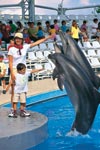
Adanda (Lamos) This ancient city is located 15 km northeast of Gazipasa, and was founded 2 km north of the present-day village of Adanda, on the top of a high and steep hill. It is a walled city with a large tower south of the city gate, and among the ruins are a fountain carved into the living rock and two temples. Other significant ruins are the tombs in the necropolis made of single pieces of carved stone. These remains are a good representation of the culture and art of the mountainous Cilician region.
Nephelis This ancient ruin can be reached by going through the village of Muzkent 12 km out on the Gazipasa-Anamur road and taking the gravel road south for about 5 km. The southern area is surrounded by the sea and steep cliffs. The city consists of the acropolis and the remains of dwellings spread out in an east-west fashion. The only standing structures date back to the Roman and Byzantine periods and include a Medieval Castle, a temple, a musical hall, irrigation system and the necropolis.
Selinus Located on the slopes in southwest of Hacimusa Creek by Gazipasa Beach, the ancient city of Selinus is one of the most important cities in the mountainous Cilician region. On the top of the hill is the acropolis as well as the walls and towers of a medieval castle, which are fairly well preserved. In the Acropolis, a church and cistern have survived the ravages of time. The other buildings of Selinus are near the beach and on the slopes, among which are the baths, agora, Islami Yapi (mansion), aqueducts and the necropolis. Most of the bones in the Alanya Museum were brought from the Necropolis and allow the workshop in the museum to exist.
Kumluca
Situated on the plane formed by the silt carried down from the mountains by Alakir Creek and Gavur Brook, Kumluca is surrounded by the towns of Finike and Elmali. In the upper reaches of Alakir Creek fed by the springs coming from Onemli Mountains and the Beydaglar Mountains, there are trout and striped mullet.
How to Get
|
By Road : Antalya is easily accessed from most parts of the country, and the main bus station (Yeni Garaj) is 4km in north of the city centre. Major routes include Istanbul (12 hours), Fethiye (8 hours), Izmir (9 hours) and Goreme (10 hours). The best route from Istanbul and Ankara is through Afyon and Burdur. In addition to the large buses and long-distance journeys, which leave from the Sehirlerarasi Terminali, there are also dolmus services to places like Kas, Alanya, Olympos and Side, from the Ilceler Terminali, although these are not air-conditioned. Most bus companies have a free shuttle service from the bus station into the city centre.
Where to Eat
|
The nomadic people living in the rural areas, raise wheat and animals, and it is these products which form the basis of the local cuisine. Though limited in scope there are fresh vegetables grown along the coast but as one moves into the interior, wheat and other crops become more common.
The primary dishes which make up the modern diet are kolle (boiled wheat, beans, chickpeas), sautéed meat with vegetables, tomato civesi, hibes, arapasi, tandir kebab and the local jellies.
|
Museum
|
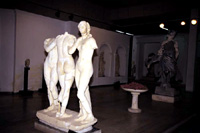 Antalya Museum : Founded in 1922 by Süleyman Fikri Erten and housed first in the Alaaddin Mosque in the old city and then in the Yivli Minaret, the museum was later moved to its current location. The museum consists of 12 exhibit rooms, gardens and open galleries. In these halls the history of Antalya is given in a chronological and instructive fashion starting with the first humans and continuing without interruption to the modern era. Antalya Museum : Founded in 1922 by Süleyman Fikri Erten and housed first in the Alaaddin Mosque in the old city and then in the Yivli Minaret, the museum was later moved to its current location. The museum consists of 12 exhibit rooms, gardens and open galleries. In these halls the history of Antalya is given in a chronological and instructive fashion starting with the first humans and continuing without interruption to the modern era.
Detailed Information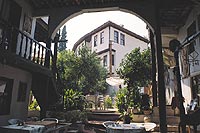 Kaleici : Today the historical old city of Antalya known as Kaleici (the inner castle) is surrounded by two walls, most of which have fallen down. The inner wall encloses the harbour in a semicircle. As a result of restoration, Kaleici has turned into a major tourist centre with guest-houses, bars, shops and restaurants, and the Roman harbour has been turned into a modern, well-equipped marina. As a result of the restoration work, the Ministry of Tourism was awarded the Golden Apple (Tourism Oscar) in April 1984 by FIJET. Kaleici : Today the historical old city of Antalya known as Kaleici (the inner castle) is surrounded by two walls, most of which have fallen down. The inner wall encloses the harbour in a semicircle. As a result of restoration, Kaleici has turned into a major tourist centre with guest-houses, bars, shops and restaurants, and the Roman harbour has been turned into a modern, well-equipped marina. As a result of the restoration work, the Ministry of Tourism was awarded the Golden Apple (Tourism Oscar) in April 1984 by FIJET.
Antalya Museum : Founded in 1922 by Suleyman Fikri Erten and housed first in the Alaaddin Mosque in the old city and then in the Yivli Minaret, the museum was later moved to its current location 2 km further east. The museum consists of 12 exhibition rooms, gardens and open galleries. In these halls the history of Antalya is given in chronological order, starting with fossils, through the Stone and Bronze ages, then through the classical and Hellenistic periods. There are mosaics, the Gallery of the Gods, Phrygian ornaments, and a room with Christian art that includes pieces of the skull and jawbone of St Nicholas, the original Santa Claus. The ethnography section has a collection of Iznik ceramics, household implements and weapons.
The City Walls : What remained today, is a few bastions inside the city as well as Hadrian's Gate and its towers, the large tower facing the harbour and a few pieces of the harbour walls. One of the wall surrounds the yacht harbour and the other the city, almost like horseshoe. One of the remaining towers in the Castle Gate Square is now used as a clock tower. There are four gates in the city walls, which form entrances to the city.
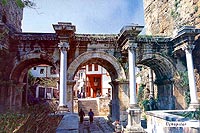 Hadrian's Gate : The only city gate to have survived until the present day is the most attractive of the Pamphylia: Uckapilar (Three Gates), also known as Hadrian's Gate, which is guarded by one tower on either side. Built to honour the emperor Hadrian's visit to the city in 130 AD, the whole gate, except for the columns, is made of pure white marble. The reliefs and carvings are extraordinary. Hadrian's Gate : The only city gate to have survived until the present day is the most attractive of the Pamphylia: Uckapilar (Three Gates), also known as Hadrian's Gate, which is guarded by one tower on either side. Built to honour the emperor Hadrian's visit to the city in 130 AD, the whole gate, except for the columns, is made of pure white marble. The reliefs and carvings are extraordinary.
Old Houses of Antalya : With its hot summers and mild winters, the houses in Antalya are designed to provide protection not against the chill of winter but against the merciless heat of summer. The stone overhangs and courtyards help provide air circulation. The houses in Antalya can be divided into three types based upon the design of the main hall, which also serves as a storage area. The three types are I halls, L halls and U halls. In the design of these houses, great attention was paid to meeting the necessities of daily life, while also providing harmony with nature and the environment.
Perge : Situated 18 km east of Antalya, Perge is in the city limits of Aksu Bucagi. Because of its location on the Cilicia - Pisidia road, it was a vital part of the province of Pamphylia, and was founded around the same time as the other cities in the area (7th century BC). It was an important city for Christians of Perge who had worshipped the mother goddess Artemis. St. Paul and Barnabas visited the city and wealthy benefactors like Magna Plancia had a number of important memorials built here.
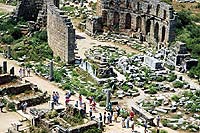 The first excavations began in 1946 by Istanbul University and they resulted in many important discoveries were that, the theatre consists of three main sections: the seating, orchestra and stage. It held 12,000 spectators, with 19 rows of seats on the lower section, 23 on the top section, and a 52-metre stage. The first excavations began in 1946 by Istanbul University and they resulted in many important discoveries were that, the theatre consists of three main sections: the seating, orchestra and stage. It held 12,000 spectators, with 19 rows of seats on the lower section, 23 on the top section, and a 52-metre stage.
The stadium measures 34 square metres, with 13 rows of seats on top of the vaults. The eastern and western sides have 30 vaults each and the northern side has 10. For every three vaults there is an entrance to the stadium, and the other two were used as shops.
The Agora was the commercial and political centre of the city, with shops surrounding the central courtyard, some of which have mosaics on the floor.
The agora measured 76 square metres, with a circular structure in the centre with a diameter of 13.40 metres.
The colonnaded boulevard lies between the Hellenistic Gate and the nympheum on the slopes of the acropolis. On both sides of the street, 20 metres in width, are porticoes, some up to five meters high, behind which are shops. The street is divided into two by a 2-metre wide water canal running through the middle.
Other structures include the necropolis, city walls, gymnasium, Roman Baths, memorial fountain and the Greek and Roman gates.
Termessos : The ruined city of Termessos, lying 34km west of Antalya in a rugged mountain valley, was founded by the Solymi people, from the interior of Anatolia. Among the important remains are, the 4200-seat theatre and the Roman stele that Augustus had built at the beginning of the first century AD. The Odeon, the covered meeting hall, has seating for 600 people. The five inter-connecting underground cisterns were used for the storage of water and olive oil.
Other important remains include the Agora, with an open western side and other sides colonnaded; the heroic memorial of Hereon on top of a 6-metre high platform; the Corinthian-style temple, the Temple of Zeus, the Lesser and Greater Temples of Artemis, the gymnasium and the watch towers. In addition, there are more than 1200 rock tombs.
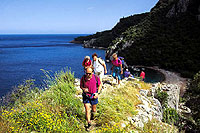 Olympos : Lying between Kemer and Adrasan is the ancient harbour village of Cirali, the ruins of Olympos and the site of the Chimaera. The history of Olympos dates back to the 2nd century BC when it was an important Lycian city, although it was empty by the 6th century. The Olympians worshipped Hephaestos (Vulcan) the god of fire, probably connected to the eternal flame, or Chimaera, which still emerges from the mountain. Known also as Yanartas (burning stone), the flame is caused by the burning of natural gas emerging from the mountain. Apart from the ruins, Olympos is well known for its simple treehouse camps, where most tourists stay, and a natural environment thanks to forests and vineyards near to a beautiful beach. Olympos : Lying between Kemer and Adrasan is the ancient harbour village of Cirali, the ruins of Olympos and the site of the Chimaera. The history of Olympos dates back to the 2nd century BC when it was an important Lycian city, although it was empty by the 6th century. The Olympians worshipped Hephaestos (Vulcan) the god of fire, probably connected to the eternal flame, or Chimaera, which still emerges from the mountain. Known also as Yanartas (burning stone), the flame is caused by the burning of natural gas emerging from the mountain. Apart from the ruins, Olympos is well known for its simple treehouse camps, where most tourists stay, and a natural environment thanks to forests and vineyards near to a beautiful beach.
Ariassos : The ancient remains of Ariassos, around 50km from Antalya, are located on a slope and contain baths and rock tombs.
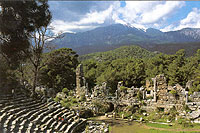 Phaselis : On the coast, 60km south of Antalya, Phaselis was founded by the Rhodians in the 7th century BC, and was known as the most important seaport in Eastern Lycia. On the west of the city is Hadrian's Gate, with shops and baths on either side. The city is accessible both by road and sea. Phaselis : On the coast, 60km south of Antalya, Phaselis was founded by the Rhodians in the 7th century BC, and was known as the most important seaport in Eastern Lycia. On the west of the city is Hadrian's Gate, with shops and baths on either side. The city is accessible both by road and sea.
Limyra : Believed to have been in existence since the 5th century, Limyra is still in existence despite a massive earthquake in the mid 19th century although was emptied in the 7th and 9th centuries after the Arab invasions. The city, which is 11km south, composes of three section; the acropolis, areas of settlement, and necropolis.
Arycanda : Excavations of this city reveal that it probably existed from the 5th century BC, and controlled much of the Arycanda valley. Having survived a destructive earthquake in 240 AD, the city maintained its prominence until the 11th century, and its most important structures still survive today.
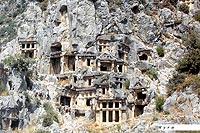 Demre (Myra) : Demre was one of the most important cities of the Lycian civilisation. 25km west of Finike and 48km east of Kas, Demre was a place of settlement from the 5th century BC. The city was deserted in 9 A.D after the invasions of the Arabs. Rock tombs, theatres and the Church of St. Nicholas (said to be the original Santa Claus) are the most interesting sites in the town today. Demre (Myra) : Demre was one of the most important cities of the Lycian civilisation. 25km west of Finike and 48km east of Kas, Demre was a place of settlement from the 5th century BC. The city was deserted in 9 A.D after the invasions of the Arabs. Rock tombs, theatres and the Church of St. Nicholas (said to be the original Santa Claus) are the most interesting sites in the town today.
Simena (Kale) : Receiving its beauty from its history, sea and sun, Simena is accessible from Ucagiz. The submerged city and the ancient remains at the opposite island of Kekova island, makes it a worthwhile trip. There are traces of Roman and other civilisations in Simena, the history of which dates back to Lycian civilisation. There is a small theatre carved into the rock, and Roman city walls.
Side: Manavgat-Side
Aspendos: The ancient city, 48km east of Antalya, is most famous for its theatre, probably the best preserved in Asia Minor. It is still in use today, and stages the annual Aspendos Opera and Ballet Festival every summer. It was the scene of a huge bloody battle between the Persians and the Greeks in 469 BC, and then ruled by the Spartans 120 years later. The city became part of the Seleucid kingdom after the death of Alexander the Great, and then became part of the Roman province of Asia in 133 BC.
The famous theatre was built in the 2nd century AD, using a Roman design, and it is still intact. Ataturk was responsible for much of the restoration, who declared that it should be used as a theatre rather than simply a museum after his visit.
In addition to the theatre, there is an acropolis on a hilltop, of which the nymphaeum and basilica are still fairly intact.
Opening hours: Summer 08.00 - 19.00; Winter 08.00 - 17.30.
Serik İlçesi-Aspendos
Kekova : It is between Kaş-Demre. It is an ancient submerged city 500 m far from the Üçağız Village in Mediterranean.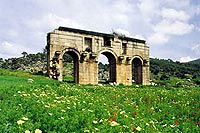 Patara : It is on Kalkan-Fethiye road,nearly 10 km before Kalkan and is located at the south.. The colorful ceramics in the center of the city reveal that the history of the city reaches back to 5 B.C. Besides its being the birth place of St. Nicholas,it was one of the most important seaports during the times of Alexander the Great. Three gated city walls,one of which leads to Patara, was constructed by the governor Modestus in 110 . One of the most important remnants is the theater currently buried under the crystal clear sandy beaches of Patara. Patara : It is on Kalkan-Fethiye road,nearly 10 km before Kalkan and is located at the south.. The colorful ceramics in the center of the city reveal that the history of the city reaches back to 5 B.C. Besides its being the birth place of St. Nicholas,it was one of the most important seaports during the times of Alexander the Great. Three gated city walls,one of which leads to Patara, was constructed by the governor Modestus in 110 . One of the most important remnants is the theater currently buried under the crystal clear sandy beaches of Patara.
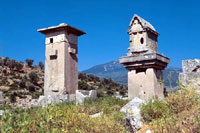 Xanthos : Founded on the Xanthos river basin,Xanthos is the biggest and the most ancient city of Lycia. Having being remained independent till the invasions of the Persians in 4292 B.C,Xanthos tried hard to defend against the invasions;however, upon realizing the remote victory the people of Xanthos first murdered their women then commited suicide as a whole.Afterwards 80 family imigrating to the region refounded the city but approximately 100 years later the city was totally destroyed by a great fire. Reesatblished city thenceforth strengtened its connection with west and became an important center.Still the city can not be saved from misfortune. Upon resisting to the taxes of the Roman Brutus, the city was ruined and the people were dragged into war. And Xanthos became the city of catastrophe. Xanthos : Founded on the Xanthos river basin,Xanthos is the biggest and the most ancient city of Lycia. Having being remained independent till the invasions of the Persians in 4292 B.C,Xanthos tried hard to defend against the invasions;however, upon realizing the remote victory the people of Xanthos first murdered their women then commited suicide as a whole.Afterwards 80 family imigrating to the region refounded the city but approximately 100 years later the city was totally destroyed by a great fire. Reesatblished city thenceforth strengtened its connection with west and became an important center.Still the city can not be saved from misfortune. Upon resisting to the taxes of the Roman Brutus, the city was ruined and the people were dragged into war. And Xanthos became the city of catastrophe.
The city was founded around center of Lycia and outside it, were the remnants of Roman city center. Roman theater and the findings at the west side of the theater still attracts the visitors. Harpy memorial on the rocks is one of the most important traces. Only the duplication of the work of art, the original of which is on exhibit in British Museum in England,can be seen in the region.
Kaş (Antiphellos) : One of the Lycian towns,Kaş took its name from the Greek word "Phellos" meaning stony place. With its well preserved rock tombs and theater, Kaş is a wonderful town on the Mediterranean coast.
Mosques And Tombs
|
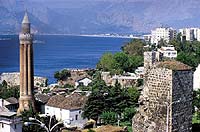 Important mosques in the area are Yivli Minaret Complex, Kesik Minaret Camii, Bali Bey Camii, Muratpasa Camii, Iskele Camii, Karatay Medrese, and Ahi Yusuf Camii and Tomb.
Antalya Mosques and Churches
Evdir Han The first stopping point on the road leading north from Antalya is the Evdir Han, lying 18 km from the centre of Antalya, a rectangular structure made of cut stone and rubble. Its most interesting feature is the sharply pointed portal. Keykavus I had the han built between 1210-1219 AD.
Kirkgoz Han It is 30 km away from Antalya, extremely well preserved, and although built by one of the sultans departs from the traditional style of their usual hans. It is made from cut stone and rubble.
|
|
Natıonal And Natural Parks
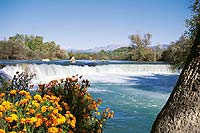 Taurus moutains with an elevation of at least 1000m height, are quite cool even in the summer and the people of Antalya and the nomadic Yoruk people spend their summers up here. The primary highland villages are Bakirli, Feslegen, Yesil Yayla and Saklikent. Taurus moutains with an elevation of at least 1000m height, are quite cool even in the summer and the people of Antalya and the nomadic Yoruk people spend their summers up here. The primary highland villages are Bakirli, Feslegen, Yesil Yayla and Saklikent.
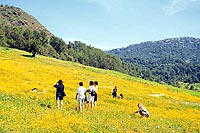
Beaches
|
Kumluca and the many coves between Antalya and Finike are home to some of the most famous holiday resorts in Turkey, like Kemer, Camyuva, Belek, Cirali and Adrasan. Closer to the city, Konyaalti is 3 km on west of the city, and Lara beach is 10 km on east and well connected by minibus.
|
Sporting Activities
|
Skiing : Within the province of Antalya, is a ski centre at Saklikent, in the Beydag mountain range, at 1850m. There are two ski lifts, restaurants, and accommodation available. The skiing season runs between January and April, and in the spring months it is possible to ski in the morning and then swim in the sea in Antalya.
Mountaineering : The Beydag mountain range has peaks ranging from 600 - 3086 m., with a variety of geological and typographical features and offer a wide range of climbing opportunities.
The important peaks are Tekedorugu, Bakirli Dag, Tahtalidag and Kizlar Sivrisi. Climbers will pass through the cedar forests of Camkuru Valley on their way to the top. The climbs can be completed in one day.
Rafting : Within the Koprulu Canyon National Park, Koprucay is among the most breathtaking rafting centres in the country. Manavagat River rushes powerfully over the rocks, and offers excellent rafting opportunities. There are a couple of agencies in the city who organise trips, including transport and equipment.
Diving : Various points of Antalya's coastline provide opportunities for diving.
Hunting : Foreigners can only hunt in parties organised by Turkish travel agencies which have been authorised by the Ministry of Agriculture and Rural Affairs. These agencies provide all information concerning seasons, authorised zones, permits, weapons and ammunition. A list of agencies can be obtained from the Union of Travel Agencies (TURSAB).
more information, contact:
- Forest Ministry, National Parks and Wildlife General Directorate, Gazi Tesisleri No 11, Gazi, Ankara.

Where to Eat
|
The nomadic people living in the rural areas, raise wheat and animals, and it is these products which form the basis of the local cuisine. Though limited in scope there are fresh vegetables grown along the coast but as one moves into the interior, wheat and other crops become more common.
The primary dishes which make up the modern diet are kolle (boiled wheat, beans, chickpeas), sautéed meat with vegetables, tomato civesi, hibes, arapasi, tandir kebab and the local jellies.
What to Buy
|
In Antalya, there are shopping malls that the foreign or local tourist could find lots of thing. The city is famous for its jams and jellies made from every fruit and vegetable imaginable. The most interesting ones are the eggplant, watermelon, bergamot and turunc jellies. There are also souvenirs and gift items particular to Turkey in the shops of the Ministry of Tourism and the Ministry of Culture and the shops in the old city. The area is famous for its Dosemealti carpets coloured with natural root dyes.
Geography
|
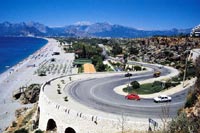 Antalya is dominated by two climates. The coastal area is typically Mediterranean with hot dry summers and mild rainy winters. The interior region has a transitional climate affected by Central Anatolia and the Mediterranean. In July and August, the temperature can reach 35 degrees, with minimal rainfall. Winters can get down to 4 degrees, and very rarely with it reach freezing point. The wettest months are December and January, with 250mm of rain per month. The average annual humidity is 61%.
|
Don't Leave Without
|
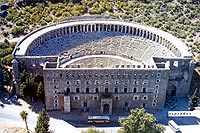 - Visiting the Antalya Museum - Visiting the Antalya Museum
- Walking up the gorge at Saklikent
- Seeing the ruins at Perge and Termessos
- Walking through Kaleici and the old houses of Antalya
- Taking pictures of the snowdrops in Akseki
- Buying a Dosemalti carpet
- Tasting the local jams and jellies
Don't return...
|
|
|
|
|
|
|
|
|
|
|
|
|
 Because of the archaeological and natural riches of the area, Antalya is also known as the Turkish Riviera. The sun, sea, nature and history combine to form a very popular resort, highlighted by some of the cleanest beaches in the Mediterranean. The 630km shoreline of the province is liberally scattered with ancient cities, harbours, memorial tombs and beaches, secluded coves and lush forests, many of which are easily accessible from the city.
Because of the archaeological and natural riches of the area, Antalya is also known as the Turkish Riviera. The sun, sea, nature and history combine to form a very popular resort, highlighted by some of the cleanest beaches in the Mediterranean. The 630km shoreline of the province is liberally scattered with ancient cities, harbours, memorial tombs and beaches, secluded coves and lush forests, many of which are easily accessible from the city. The exact founding date of Elmali, which is located within the borders of ancient Lycia, is unknown. Excavations to the east at Karatas near the village of Semahoyuk, and to the west in the village of Beyler indicate that the area has been inhabited seen the Bronze Age.
The exact founding date of Elmali, which is located within the borders of ancient Lycia, is unknown. Excavations to the east at Karatas near the village of Semahoyuk, and to the west in the village of Beyler indicate that the area has been inhabited seen the Bronze Age.
 Antalya Museum : Founded in 1922 by Süleyman Fikri Erten and housed first in the Alaaddin Mosque in the old city and then in the Yivli Minaret, the museum was later moved to its current location. The museum consists of 12 exhibit rooms, gardens and open galleries. In these halls the history of Antalya is given in a chronological and instructive fashion starting with the first humans and continuing without interruption to the modern era.
Antalya Museum : Founded in 1922 by Süleyman Fikri Erten and housed first in the Alaaddin Mosque in the old city and then in the Yivli Minaret, the museum was later moved to its current location. The museum consists of 12 exhibit rooms, gardens and open galleries. In these halls the history of Antalya is given in a chronological and instructive fashion starting with the first humans and continuing without interruption to the modern era.
 Hadrian's Gate : The only city gate to have survived until the present day is the most attractive of the Pamphylia: Uckapilar (Three Gates), also known as Hadrian's Gate, which is guarded by one tower on either side. Built to honour the emperor Hadrian's visit to the city in 130 AD, the whole gate, except for the columns, is made of pure white marble. The reliefs and carvings are extraordinary.
Hadrian's Gate : The only city gate to have survived until the present day is the most attractive of the Pamphylia: Uckapilar (Three Gates), also known as Hadrian's Gate, which is guarded by one tower on either side. Built to honour the emperor Hadrian's visit to the city in 130 AD, the whole gate, except for the columns, is made of pure white marble. The reliefs and carvings are extraordinary.
 Olympos : Lying between Kemer and Adrasan is the ancient harbour village of Cirali, the ruins of Olympos and the site of the Chimaera. The history of Olympos dates back to the 2nd century BC when it was an important Lycian city, although it was empty by the 6th century. The Olympians worshipped Hephaestos (Vulcan) the god of fire, probably connected to the eternal flame, or Chimaera, which still emerges from the mountain. Known also as Yanartas (burning stone), the flame is caused by the burning of natural gas emerging from the mountain. Apart from the ruins, Olympos is well known for its simple treehouse camps, where most tourists stay, and a natural environment thanks to forests and vineyards near to a beautiful beach.
Olympos : Lying between Kemer and Adrasan is the ancient harbour village of Cirali, the ruins of Olympos and the site of the Chimaera. The history of Olympos dates back to the 2nd century BC when it was an important Lycian city, although it was empty by the 6th century. The Olympians worshipped Hephaestos (Vulcan) the god of fire, probably connected to the eternal flame, or Chimaera, which still emerges from the mountain. Known also as Yanartas (burning stone), the flame is caused by the burning of natural gas emerging from the mountain. Apart from the ruins, Olympos is well known for its simple treehouse camps, where most tourists stay, and a natural environment thanks to forests and vineyards near to a beautiful beach. Phaselis : On the coast, 60km south of Antalya, Phaselis was founded by the Rhodians in the 7th century BC, and was known as the most important seaport in Eastern Lycia. On the west of the city is Hadrian's Gate, with shops and baths on either side. The city is accessible both by road and sea.
Phaselis : On the coast, 60km south of Antalya, Phaselis was founded by the Rhodians in the 7th century BC, and was known as the most important seaport in Eastern Lycia. On the west of the city is Hadrian's Gate, with shops and baths on either side. The city is accessible both by road and sea. Demre (Myra) : Demre was one of the most important cities of the Lycian civilisation. 25km west of Finike and 48km east of Kas, Demre was a place of settlement from the 5th century BC. The city was deserted in 9 A.D after the invasions of the Arabs. Rock tombs, theatres and the Church of St. Nicholas (said to be the original Santa Claus) are the most interesting sites in the town today.
Demre (Myra) : Demre was one of the most important cities of the Lycian civilisation. 25km west of Finike and 48km east of Kas, Demre was a place of settlement from the 5th century BC. The city was deserted in 9 A.D after the invasions of the Arabs. Rock tombs, theatres and the Church of St. Nicholas (said to be the original Santa Claus) are the most interesting sites in the town today.
 Xanthos : Founded on the Xanthos river basin,Xanthos is the biggest and the most ancient city of Lycia. Having being remained independent till the invasions of the Persians in 4292 B.C,Xanthos tried hard to defend against the invasions;however, upon realizing the remote victory the people of Xanthos first murdered their women then commited suicide as a whole.Afterwards 80 family imigrating to the region refounded the city but approximately 100 years later the city was totally destroyed by a great fire. Reesatblished city thenceforth strengtened its connection with west and became an important center.Still the city can not be saved from misfortune. Upon resisting to the taxes of the Roman Brutus, the city was ruined and the people were dragged into war. And Xanthos became the city of catastrophe.
Xanthos : Founded on the Xanthos river basin,Xanthos is the biggest and the most ancient city of Lycia. Having being remained independent till the invasions of the Persians in 4292 B.C,Xanthos tried hard to defend against the invasions;however, upon realizing the remote victory the people of Xanthos first murdered their women then commited suicide as a whole.Afterwards 80 family imigrating to the region refounded the city but approximately 100 years later the city was totally destroyed by a great fire. Reesatblished city thenceforth strengtened its connection with west and became an important center.Still the city can not be saved from misfortune. Upon resisting to the taxes of the Roman Brutus, the city was ruined and the people were dragged into war. And Xanthos became the city of catastrophe. Important mosques in the area are Yivli Minaret Complex, Kesik Minaret Camii, Bali Bey Camii, Muratpasa Camii, Iskele Camii, Karatay Medrese, and Ahi Yusuf Camii and Tomb.
Important mosques in the area are Yivli Minaret Complex, Kesik Minaret Camii, Bali Bey Camii, Muratpasa Camii, Iskele Camii, Karatay Medrese, and Ahi Yusuf Camii and Tomb.


 Antalya is dominated by two climates. The coastal area is typically Mediterranean with hot dry summers and mild rainy winters. The interior region has a transitional climate affected by Central Anatolia and the Mediterranean. In July and August, the temperature can reach 35 degrees, with minimal rainfall.
Antalya is dominated by two climates. The coastal area is typically Mediterranean with hot dry summers and mild rainy winters. The interior region has a transitional climate affected by Central Anatolia and the Mediterranean. In July and August, the temperature can reach 35 degrees, with minimal rainfall. - Visiting the Antalya Museum
- Visiting the Antalya Museum
No comments:
Post a Comment